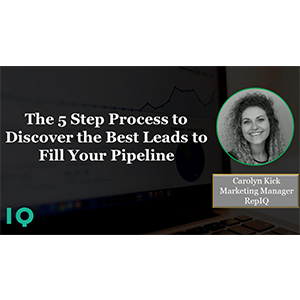 Prospecting can often be the most difficult part of the sales process. In fact, according to CSO Insights, 68% of companies site generating high-quality leads as their toughest sales challenge. Many traditional lead generation strategies are both ineffective and inefficient. On average, 73% of the leads sales deal with are unqualified. These “bad” leads can have wide-ranging negative effects like:
Prospecting can often be the most difficult part of the sales process. In fact, according to CSO Insights, 68% of companies site generating high-quality leads as their toughest sales challenge. Many traditional lead generation strategies are both ineffective and inefficient. On average, 73% of the leads sales deal with are unqualified. These “bad” leads can have wide-ranging negative effects like:
- Higher revenue volatility (unpredictable MRR/ARR)
- Wasting sales time on leads who are never going to buy
- If won, wasting customer support/AE’s time managing a poor-fit account
- If won, customer is more likely to churn over time
With traditional prospecting strategies such as auto-generated lead lists and mass cold email campaigns, it’s no wonder that 50% of sales time is wasted on unproductive prospecting!
Here at RepIQ, we focus on developing more effective prospecting methods. We believe that when you discover and sell to the right leads for your business you can reap benefits such as:
- Shorter sales cycle
- Higher ACV and LTV
- Happier customers
- Less customer churn
These five steps will teach you how to discover, target, and sell to the best leads for your business.
- Pinpoint & analyze your best customers
The first step in better lead generation is to pinpoint who your best customers are. You can analyze these customers to determine the type of leads you should be targeting. If you’re not sure who your best customers are, consider customers who have:
- Been with you for the longest
- Increased their lifetime value (LTV) through expansions, upsells, and/or cross-sales
- Provided referrals, testimonials, and/or references (brand advocates)
- Had a low cost of acquisition at the time of sale (CAC)
- Had a short sales cycle at the time of sale
- Generated the most revenue for your company (high LTV)
- Required little customer support
Once you’ve identified 5-10 of your best customers, analyze them to discover traits they have in common. Look at these customers and consider:
- What traits do these customers have in common?
- At the point of sale, what was the value proposition?
- At the point of sale, why was the timing right for the customer to make a purchase decision?
- Why are these customers a great fit for your business?
- Why have they stayed loyal to you year after year?
If you’re unsure of the answers to these questions, it can be helpful to schedule discovery calls with your best customers. These calls can provide important insights into the type of customers you should be focusing your lead generation efforts on.
- Create an ideal customer profile (ICP)
Use the key insights you discovered in step #1 to create an ideal customer profile (ICP). An ICP is a pre-defined set of demographic, technographic, and sales triggers which describe your ideal customer.
An ICP is made up of three key criteria:
- Demographics: Basic information like industry, location, company size, annual revenues, etc.
- Technographics: What technologies a company uses to power its operations. For example: Salesforce, Marketo, HubSpot, MailChimp, Gmail, etc. This is especially important for those selling technology or software-based products.
- Sales triggers: Timely events which indicate it’s an opportune time for a purchase-decision to be made. For example: company expansion, new product release, press coverage, good or bad quarter, hiring new employees, etc.
Here’s an example ICP:

Image Source: Hyde Park Angels Blog
- Create a negative buyer persona
In addition to having an ICP, it’s also important to identify disqualifying traits for potential leads. This will help your sales team avoid wasting time on leads who will never buy. Analyze the customers you’ve lost over time. You can also look at deals you thought you would win but didn’t. Consider:
- What traits do these companies have in common?
- Why were they a bad fit for your business?
- What was the most important deciding factor for them not moving forward with your product/service?
- Why was the timing not right for a long-term purchase decision?
- What key criteria was missing that would have made these customers a better fit?
Use these findings to create a list of negative buyer traits. Here’s an example of disqualifying buyer traits:

4. Discover leads who match your ICP
Now that you’ve defined who you should be selling to and who you shouldn’t be selling to, it’s time to find leads who match your ICP. Here at RepIQ, we’ve discovered two methods for doing this. The first is to leverage LinkedIn. You can use LinkedIn’s search filters to input characteristics from your ICP such as location, industry, and prospect job title. Here’s an example for the auto-industry ICP we covered in step #2:

The positive of using LinkedIn is that everyone has access to it. On the negative side, it doesn’t include advanced search filters without a paid premium account, making it difficult to get granular with your ICP when using LinkedIn for free.
This is why our preferred method is to use a tool specifically designed to help you discover leads who match your ICP. Here at RepIQ, our lead generation tool includes numerous search fields which can help you discover the best leads who perfectly match your ICP. In this example using RepIQ, I’ve used filters to search by relevant job titles, location, industry keywords, company size, and desired technology:

5. Refine & optimize your ICP over time
As with all sales activities, it’s important to set goals and track your progress towards those goals. Since your ICP will now guide your lead generation efforts, you should set an aggressive sales goal to measure the effectiveness of your ICP. Some great goals include:
- Increase MRR by X%
- Increase your conversion rate by X%
- Increase the size of our by pipeline by X%
- Reduce customer attrition by X%
You can use this data to refine and optimize your IPC over time and make your lead generation efforts even more effective.
Prospecting can be challenging, but with an ICP and disqualifying buyer traits you can start finding and selling to the best customers for your business.
 Carolyn Kick is the Marketing Manager at RepIQ. RepIQ’s prospect database and lead generation tools help salespeople discover the right customers for their business.
Carolyn Kick is the Marketing Manager at RepIQ. RepIQ’s prospect database and lead generation tools help salespeople discover the right customers for their business.
Share This Story, Choose Your Platform!
What our happy clients are saying
Let Us Help You Source the Sales Talent You Need
Whether you’re building a team or replacing a key role, our Candidate Sourcing Platform provides a fast, flexible, and employer-focused solution.
Tell us more about your business and how we can help.
Treeline Inc.
Your Award-Winning Sales Recruitment Partner
15 Lincoln Street, Suite 314, Wakefield, MA 01880













